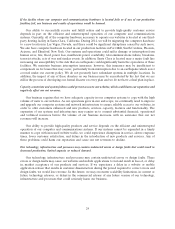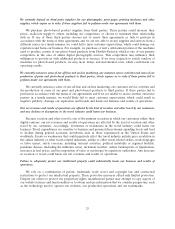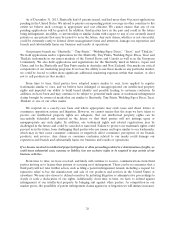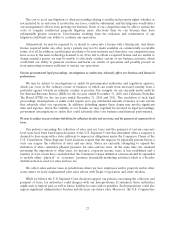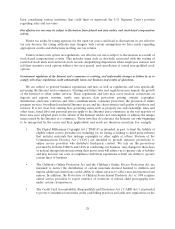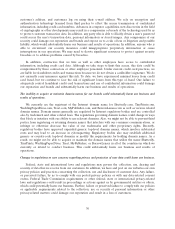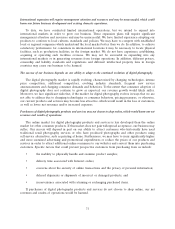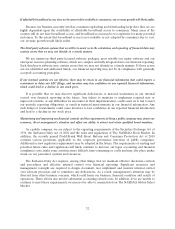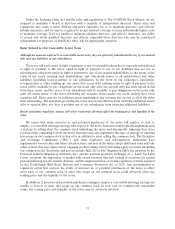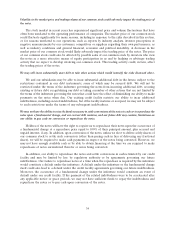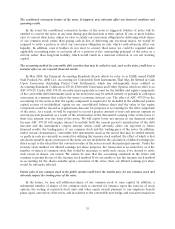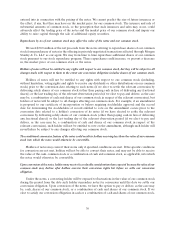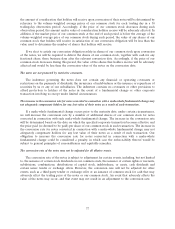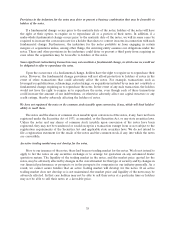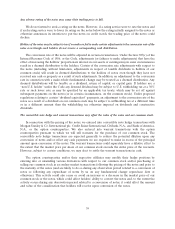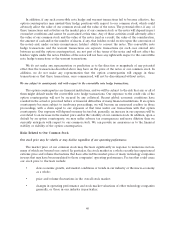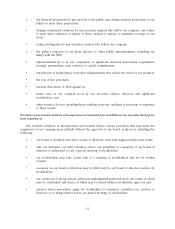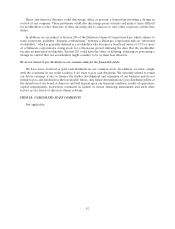Shutterfly 2013 Annual Report Download - page 35
Download and view the complete annual report
Please find page 35 of the 2013 Shutterfly annual report below. You can navigate through the pages in the report by either clicking on the pages listed below, or by using the keyword search tool below to find specific information within the annual report.Under the Sarbanes-Oxley Act and the rules and regulations of The NASDAQ Stock Market, we are
required to maintain a board of directors with a majority of independent directors. These rules and
regulations may make it more difficult and more expensive for us to maintain directors’ and officers’
liability insurance, and we may be required to accept reduced coverage or incur substantially higher costs
to maintain coverage. If we are unable to maintain adequate directors’ and officers’ insurance, our ability
to recruit and retain qualified directors and officers, especially those directors who may be considered
independent for purposes of NASDAQ rules, will be significantly curtailed.
Risks Related to Our Convertible Senior Notes
Although the notes are referred to as convertible senior notes, they are effectively subordinated to any of our secured
debt and any liabilities of our subsidiaries.
The notes will rank senior in right of payment to any of our indebtedness that is expressly subordinated
in right of payment to the notes; equal in right of payment to any of our liabilities that are not so
subordinated; effectively junior in right of payment to any of our secured indebtedness to the extent of the
value of the assets securing such indebtedness; and structurally junior to all indebtedness and other
liabilities (including trade payables) of our subsidiaries. In the event of our bankruptcy, liquidation,
reorganization or other winding up, our assets that secure debt ranking senior in right of payment to the
notes will be available to pay obligations on the notes only after the secured debt has been repaid in full
from these assets, and the assets of our subsidiaries will be available to pay obligations on the notes only
after all claims senior to the notes (including any amounts drawn under our credit facility) have been
repaid in full. There may not be sufficient assets remaining to pay amounts due on any or all of the notes
then outstanding. The indenture governing the notes does not prohibit us from incurring additional senior
debt or secured debt, nor does it prohibit any of our subsidiaries from incurring additional liabilities.
Recent and future regulatory actions and other events may adversely affect the trading price and liquidity of the
notes.
We expect that many investors in, and potential purchasers of, the notes will employ, or seek to
employ, a convertible arbitrage strategy with respect to the notes. Investors would typically implement such
a strategy by selling short the common stock underlying the notes and dynamically adjusting their short
position while continuing to hold the notes. Investors may also implement this type of strategy by entering
into swaps on our common stock in lieu of or in addition to short selling the common stock. The Securities
and Exchange Commission (‘‘SEC’’) and other regulatory and self-regulatory authorities have
implemented various rules and taken certain actions, and may in the future adopt additional rules and take
other actions, that may impact those engaging in short selling activity involving equity securities (including
our common stock). Such rules and actions include Rule 201 of SEC Regulation SHO, the adoption by the
Financial Industry Regulatory Authority, Inc. and the national securities exchanges of a ‘‘Limit Up-Limit
Down’’ program, the imposition of market-wide circuit breakers that halt trading of securities for certain
periods following specific market declines, and the implementation of certain regulatory reforms required
by the Dodd-Frank Wall Street Reform and Consumer Protection Act of 2010. Any governmental or
regulatory action that restricts the ability of investors in, or potential purchasers of, the notes to effect
short sales of our common stock or enter into swaps on our common stock could adversely affect the
trading price and the liquidity of the notes.
In addition, if investors and potential purchasers seeking to employ a convertible arbitrage strategy are
unable to borrow or enter into swaps on our common stock, in each case on commercially reasonable
terms, the trading price and liquidity of the notes may be adversely affected.
33



